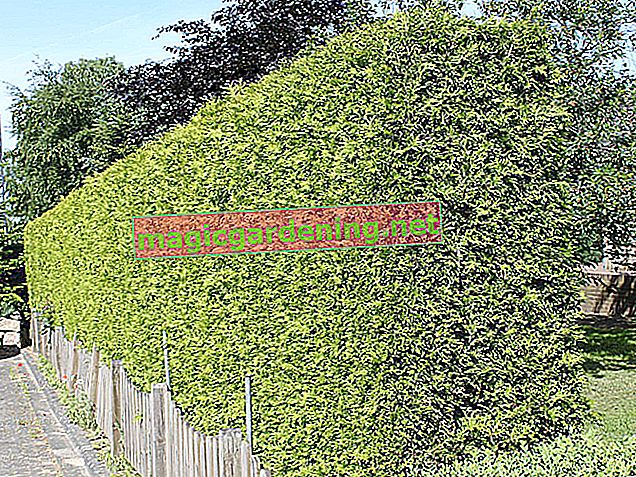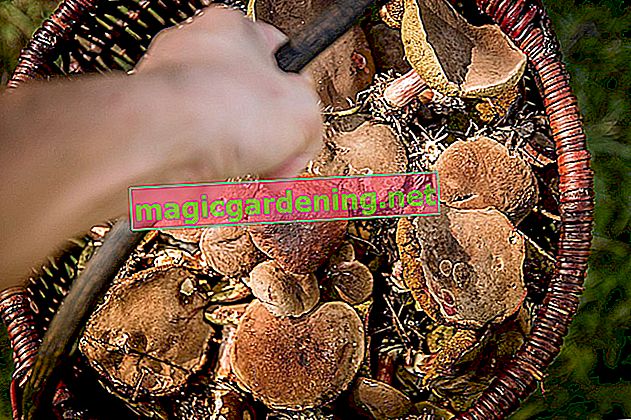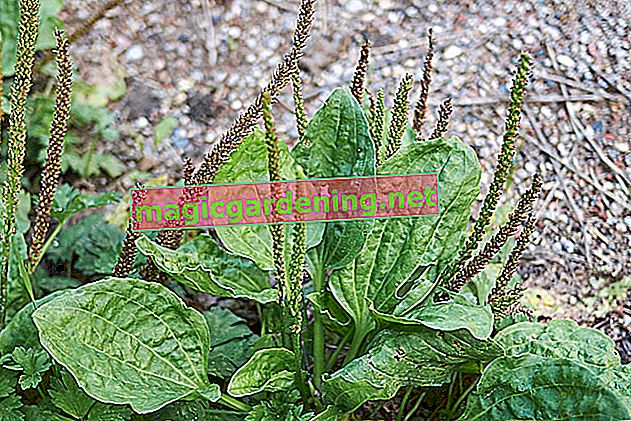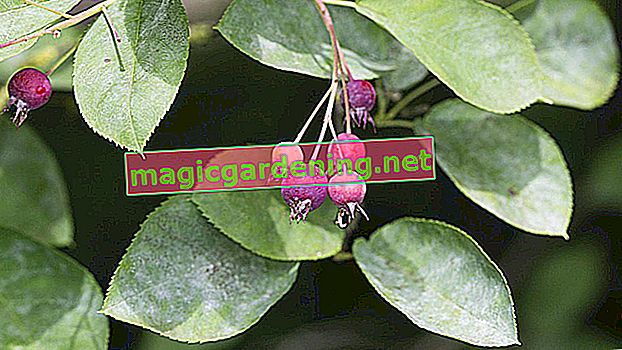
Pruning doubles the number of flowers - that's why you should cut
In the growth behavior of the 80 hydrangea species, the panicle hydrangea is out of the ordinary in one respect. While the use of secateurs is mostly taboo with farmer's hydrangeas (Hydrangea macrophylla), hydrangea paniculata bloom all the more luxuriantly after a courageous pruning. In fact, every cut on the respective shoot is rewarded with twice the number of flowers compared to the summer of the previous year. The explanation is very simple:
also read
- Panicle hydrangea loves the sun
- It is best to plant panicle hydrangea in spring
- Raising panicle hydrangea with trunk: Here's how
Panicle hydrangeas lay their buds on this year's wood . There are two leaf or shoot buds exactly opposite each other. If you follow the cutting instructions in this tutorial, both buds below an intersection will be encouraged to sprout cheerfully with numerous flower buds.
The target determines the type of cut - an overview
With the right cut, a well-formed, lavishly blooming panicle hydrangea is within reach. No other type of hydrangea is similarly dependent on targeted pruning, which begins in the first year. So that your panicle hydrangea shows its most beautiful side every year, the focus is on these 3 cutting types:
| Cut types | target | Period |
|---|---|---|
| Construction cut | well-formed basic structure | 1st to 4th year |
| Shape and clearance cut | compact growth, opulent abundance of flowers | from the 5th year |
| Upbringing to become a high tribe | slender, stable trunk with a flower-rich, harmonious crown | starting with planting |
With the instructions for structure, shape and clearing cut, this tutorial is aimed at home gardeners who want a flower-rich panicle hydrangea as an ornamental shrub in beds or tubs. For the cultivation of panicle hydrangeas in the small garden, front yard and tubs, the instructions for training pruning are intended as a high trunk.
Tips
In tree nurseries and garden centers, panicle hydrangeas are grown in containers. This has the advantage that you can plant the valuable flowering bushes at any time of the year in frost-free weather. In contrast to bare-root goods, the young shrubs are not pruned .
The best time is in late winter
In order for a panicle hydrangea to be in full bloom from July, the cutting time must not be chosen too late in spring. The robust frost hardiness of the hydrangea species makes it possible to use scissors as early as the end of February / beginning of March. This choice of date is also in accordance with the provisions of the Federal Nature Conservation Act. Vigorous pruning of woody trees is allowed up to March 1st, because this is when the breeding season for native birds begins.
Instructions for the assembly cut
A well-proportioned panicle hydrangea does not form by itself. A compact habit and abundance of flowers are the result of expert pruning right from the start. The aim is to build up 5 to 7 scaffold shoots in order to achieve the desired shrub height on the basis of this structure over the course of the first 4 standing years. This is how the construction cut succeeds with flying colors:
- In the first year of standing, select 5 to 7 of the strongest ground shoots and shorten to 20 cm
- Cut off all others close to the ground
- From the second year of standing, extend the scaffolding drives in stages to the desired height
- Cut ground shoots without scaffolding function at ground level
Starting with the second year, you no longer cut back all shoots to the same length. To achieve a natural growth habit, shorten the outer branches to 1 to 2 pairs of buds. Cut the ground shoots positioned inside the shrub back to 3 to 4 pairs of buds. In this way, you give your panicle hydrangea a semicircular dome shape, which is equally advantageous for large and small varieties.
Instructions for the shape and clearance cut
At the beginning of the fifth year, the structural cut ends in an annual shape and clearance cut. If your panicle hydrangea presents itself with a stable framework of ground shoots that branch near the base and lavishly bloom on the new wood every year, you have done everything right. To keep it that way, continue with the maintenance of the cut:
- From the fifth year onwards, remove 2 to 3 of the oldest ground shoots without a trace
- Cut back strong young shoots to 20 to 30 cm as a substitute, cut the rest off near the ground
- Shorten the outer side shoots to 1 to 2 and the inner side shoots to 3 to 4 pairs of buds
There is no need to worry if your panicle hydrangea then takes its time until April to sprout new blossoms. The deep cut is intended to awaken the sleeping eyes at the base of the shoots to floral life. This process can drag on for a few weeks and then sets in with great vehemence.

Digression
The cutting tool
You need sharp one-handed secateurs for the annual shape and clearing cut of a panicle. The tool should lie comfortably in the hand, run smoothly and have shock absorbers so that you can work safely and without fatigue. The specialist trade has just as extensive an offer for left-handers as for right-hand gardeners. The choice between bypass or anvil mechanism is based on your personal preferences. If outdated ground shoots with a diameter of more than 3 centimeters need to be cut, we recommend having a handy folding saw close at hand. The blades should be sharpened and disinfected before cutting .High Tribe Education - Here's How To Do It Right
A young panicle hydrangea is ideal for training to become a picturesque high stem. The good-natured cut tolerance as well as the ability to shoot out of sleeping eyes near the base of the shoot make the flowering hydrangea species a prime example for the upbringing of the tall trunk. As a starting point, choose a young plant that is grown and has a strong central shoot with a height of between 60 and 100 centimeters. Here's a step-by-step approach to parenting:
Pruning in the year of planting
In the year of planting in the bed or tub, you determine the strongest central shoot for the future trunk. Cut off all vertically aligned competition shoots at ground level. You attach the main drive to a support rod, as shown in the figure below.
Parental cut after one year
After the first year of standing, you determine the trunk height and the position of the later crown. To do this, count 5 pairs of buds above the desired stem height on the main shoot. There you place the scissors over the upper pair of buds, as explained in the section on the cutting technique. In the course of the summer growth phase, new shoots sprout from the buds and form the crown, as shown in the figure below.
Form and clearance cut in the following years
Once you have started the formation of the crown, the annual pruning aims to preserve the shape and promote the abundance of flowers. Every spring remove shoots that compete with the trunk as well as side shoots that should not be part of the crown. Shorten the withered crown shoots from the previous year to one or two pairs of buds. From the fourth year onwards, you can also thin out the crown by completely removing old shoots. The aim of the pruning is a light-flooded crown, the branches of which have leaves and flowers from the base to the tip.
It all depends on the cutting technique - this is how it works
When pruning, act according to the rule of thumb: cut panicle hydrangea on buds. This premise applies regardless of whether it is a training or clearing cut. Please apply the scissors in such a way that the thickened vegetation points are not damaged and water can drain away from the cut. Avoid a longer stub that dies and hinders rapid wound healing. The figure below shows how to do it right.

If a panicle hydrangea gets old, aging ground shoots are completely removed inside and outside. With the so-called thinning out, you don't have to look out for leaf or flower buds. Place the scissors or saw near the ground to make room for fresh growth from the rootstock. If a small cone remains from the thinned ground shoot, it dries up in the course of the summer, while fresh shoots sprout from the rhizome elsewhere.
Profile with elementary facts about the cut
The following profile sums up all the facts that are important for your decision about the right cut. If you are familiar with the key functions of growth, you will always know exactly when and how to professionally prune your panicle hydrangeas:
- Belongs to the genus hydrangeas (Hydrangea)
- Name of the species: Panicle hydrangea (Hydrangea paniculata)
- Growth: persistent, upright, deciduous flowering shrub
- Growth height: 200 to 300 cm, dwarf varieties 100 to 150 cm
- Annual growth: 15 to 30 cm
- Flowering period: July to November
- Bud arrangement of flowers: on this year's wood
- Arrangement of the buds: in pairs, opposite
- Winter hardiness: well hardy
- Cut tolerance: excellent
- Toxic content: slightly toxic
In contrast to the vast majority of popular farmer's hydrangeas, panicle hydrangeas require rethinking when pruning. At the beginning of the flowering period, farm hydrangeas already have the inflorescences for the next year's flowering period. The pruning is limited to cleaning out withered flowers in autumn or spring. There is still no trace of flower buds on panicle hydrangeas in early spring. The aim here is to lure out the fresh wood through the shape and clearing cut, on which this year's inflorescences will then develop.
Frequently asked questions
Can I use cut shoots as cuttings?
The cut profile shows that a panicle hydrangea is blooming on the new wood. The cut shoots from the previous year only have a low level of vitality. If you want to propagate the summer bloomer with cuttings, wait until June / July. Life pulsates in the fresh shoot of a panicle hydrangea, so that the shoot tips are ideal for use as cuttings.
Cut off dead flowers in autumn or not?
Many home gardeners perceive the withered flowers as a visual disruptive factor in the autumnal appearance of the garden. It will not affect the flowering time of the following year if you prune a panicle hydrangea in the fall. Cut off a withered flower above a pair of leaves. In mild winter locations, you can use this opportunity to carry out the complete shape and clearing cut.
3 typical mistakes
Are you struggling with a panicle hydrangea whose shape is reminiscent of an old shaving brush, has hardly any leaves on the inside and is noticeably less blooming? Then please take a look at these 3 typical pruning mistakes that home gardeners often make:
| error | episode | correction |
|---|---|---|
| never exposed | impenetrable, dense ramifications, few flowers on the shoot tips | Thinning out old ground shoots regularly, maintain bush training with 5 to 7 scaffold shoots |
| too timid pruning | increasing baldness from below, declining flowering potential | annual strong pruning of all shoots by up to two thirds |
| all branches cut back linearly to the same height | unnatural growth habit that falls apart | Cut the shoots inside the bush to 4 pairs of buds, shorten the outer branches to 2 pairs of buds |
Can you spot one of these common mistakes as the cause of disfigured panicle hydrangea? Then don't be afraid to radically shorten the entire shrub next spring. The good-natured cut tolerance allows the ornamental wood to regain its new shine once more with the structure, shape and clearance cut of this tutorial.
YoutubeTips
Transplanting a panicle hydrangea is inextricably linked with pruning. The move to another location is accompanied by a loss of root volume. This loss is compensated by cutting back the shoots in a proportional ratio. This premise applies regardless of whether you move the flowering shrub in autumn or spring.








